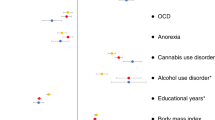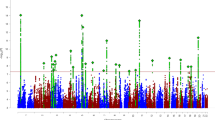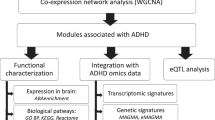Abstract
Attention deficit/hyperactivity disorder (ADHD) is one of the most common neuropsychiatric disorders with a worldwide prevalence around 4–5% in children and 1–4% in adults. Although ADHD is highly heritable and familial risk may contribute most strongly to the persistent form of the disorder, there are few studies on the genetics of ADHD in adults. In this paper, we present the first results of the International Multicentre Persistent ADHD Genetics CollaboraTion (IMpACT) that has been set up with the goal of performing research into the genetics of persistent ADHD. In this study, we carried out a combined analysis as well as a meta-analysis of the association of the SLC6A3/DAT1 gene with persistent ADHD in 1440 patients and 1769 controls from IMpACT and an earlier report. DAT1, encoding the dopamine transporter, is one of the most frequently studied genes in ADHD, though results have been inconsistent. A variable number tandem repeat polymorphism (VNTR) in the 3′-untranslated region (UTR) of the gene and, more recently, a haplotype of this VNTR with another VNTR in intron 8 have been the target of most studies. Although the 10/10 genotype of the 3′-UTR VNTR and the 10-6 haplotype of the two VNTRs are thought to be risk factors for ADHD in children, we found the 9/9 genotype and the 9-6 haplotype associated with persistent ADHD. In conclusion, a differential association of DAT1 with ADHD in children and in adults might help explain the inconsistencies observed in earlier association studies. However, the data might also imply that DAT1 has a modulatory rather than causative role in ADHD.
Similar content being viewed by others
Log in or create a free account to read this content
Gain free access to this article, as well as selected content from this journal and more on nature.com
or
References
Asherson P, Brookes K, Franke B, Chen W, Gill M, Ebstein RP et al (2007). Confirmation that a specific haplotype of the dopamine transporter gene is associated with combined-type ADHD. Am J Psychiatry 164: 674–677.
Barkley RA, Fischer M, Smallish L, Fletcher K (2006a). Young adult outcome of hyperactive children: adaptive functioning in major life activities. J Am Acad Child Adolesc Psychiatry 45: 192–202.
Barkley RA, Smith KM, Fischer M, Navia B (2006b). An examination of the behavioral and neuropsychological correlates of three ADHD candidate gene polymorphisms (DRD4 7+, DBH TaqI A2, and DAT1 40 bp VNTR) in hyperactive and normal children followed to adulthood. Am J Med Genet B Neuropsychiatr Genet 141: 487–498.
Bernfort L, Nordfeldt S, Persson J (2008). ADHD from a socio-economic perspective. Acta Paediatr 97: 239–245.
Bertolino A, Di GA, Blasi G, Sambataro F, Caforio G, Sinibaldi L et al (2008). Epistasis between dopamine regulating genes identifies a nonlinear response of the human hippocampus during memory tasks. Biol Psychiatry 64: 226–234.
Biederman J, Mick E, Faraone SV (2000). Age-dependent decline of symptoms of attention deficit hyperactivity disorder: impact of remission definition and symptom type. Am J Psychiatry 157: 816–818.
Brookes KJ, Mill J, Guindalini C, Curran S, Xu X, Knight J et al (2006). A common haplotype of the dopamine transporter gene associated with attention-deficit/hyperactivity disorder and interacting with maternal use of alcohol during pregnancy. Arch Gen Psychiatry 63: 74–81.
Brookes KJ, Neale BM, Sugden K, Khan N, Asherson P, D’Souza UM (2007). Relationship between VNTR polymorphisms of the human dopamine transporter gene and expression in post-mortem midbrain tissue. Am J Med Genet B Neuropsychiatr Genet 144B: 1070–1078.
Brookes KJ, Xu X, Anney R, Franke B, Zhou K, Chen W et al (2008). Association of ADHD with genetic variants in the 5′-region of the dopamine transporter gene: evidence for allelic heterogeneity. Am J Med Genet B Neuropsychiatr Genet 147B: 1519–1523.
Bruggemann D, Sobanski E, Alm B, Schubert T, Schmalzried H, Philipsen A et al (2007). No association between a common haplotype of the 6 and 10-repeat alleles in intron 8 and the 3′UTR of the DAT1 gene and adult attention deficit hyperactivity disorder. Psychiatr Genet 17: 121.
Cook Jr EH, Stein MA, Krasowski MD, Cox NJ, Olkon DM, Kieffer JE et al (1995). Association of attention-deficit disorder and the dopamine transporter gene. Am J Hum Genet 56: 993–998.
DerSimonian R, Laird N (1986). Meta-analysis in clinical trials. Control Clin Trials 7: 177–188.
Diamond A (2007). Consequences of variations in genes that affect dopamine in prefrontal cortex. Cereb Cortex 17 (Suppl 1): i161–i170.
Faraone SV (2002). Report from the third international meeting of the Attention-Deficit Hyperactivity Disorder Molecular Genetics Network. Am J Med Genet 114: 272–276.
Faraone SV (2003). Report from the 4th international meeting of the attention deficit hyperactivity disorder molecular genetics network. Am J Med Genet B Neuropsychiatr Genet 121: 55–59.
Faraone SV (2004). Genetics of adult attention-deficit/hyperactivity disorder. Psychiatr Clin North Am 27: 303–321.
Faraone SV, Biederman J, Mick E (2006). The age-dependent decline of attention deficit hyperactivity disorder: a meta-analysis of follow-up studies. Psychol Med 36: 159–165.
Faraone SV, Biederman J, Spencer T, Wilens T, Seidman LJ, Mick E et al (2000). Attention-deficit/hyperactivity disorder in adults: an overview. Biol Psychiatry 48: 9–20.
Faraone SV, Perlis RH, Doyle AE, Smoller JW, Goralnick JJ, Holmgren MA et al (2005). Molecular genetics of attention-deficit/hyperactivity disorder. Biol Psychiatry 57: 1313–1323.
Faraone SV, Spencer T, Aleardi M, Pagano C, Biederman J (2004). Meta-analysis of the efficacy of methylphenidate for treating adult attention-deficit/hyperactivity disorder. J Clin Psychopharmacol 24: 24–29.
Fleiss J (1981). Statistical Methods for Rates and Proportions. In. Wiley: New York.
Franke B, Hoogman M, Arias VA, Heister JG, Savelkoul PJ, Naber M et al (2008). Association of the dopamine transporter (SLC6A3/DAT1) gene 9-6 haplotype with adult ADHD. Am J Med Genet B Neuropsychiatr Genet 147B: 1576–1579.
Goodman DW (2007). The consequences of attention-deficit/hyperactivity disorder in adults. J Psychiatr Pract 13: 318–327.
Guindalini C, Howard M, Haddley K, Laranjeira R, Collier D, Ammar N, et al (2006). A dopamine transporter gene functional variant associated with cocaine abuse in a Brazilian sample. Proc Natl Acad Sci USA 103: 4552–4557
Guo G, Roettger ME, Shih JC (2007). Contributions of the DAT1 and DRD2 genes to serious and violent delinquency among adolescents and young adults. Hum Genet 121: 125–136.
Halleland H, Lundervold AJ, Halmoy A, Haavik J, Johansson S (2008). Association between Catechol O-methyltransferase (COMT) haplotypes and severity of hyperactivity symptoms in Adults. Am J Med Genet B Neuropsychiatr Genet 150B: 403–410.
Kessler RC, Adler L, Ames M, Barkley RA, Birnbaum H, Greenberg P et al (2005a). The prevalence and effects of adult attention deficit/hyperactivity disorder on work performance in a nationally representative sample of workers. J Occup Environ Med 47: 565–572.
Kessler RC, Adler L, Barkley R, Biederman J, Conners CK, Demler O et al (2006). The prevalence and correlates of adult ADHD in the United States: results from the National Comorbidity Survey Replication. Am J Psychiatry 163: 716–723.
Kessler RC, Adler LA, Barkley R, Biederman J, Conners CK, Faraone SV et al (2005b). Patterns and predictors of attention-deficit/hyperactivity disorder persistence into adulthood: results from the national comorbidity survey replication. Biol Psychiatry 57: 1442–1451.
Kooij JJ, Buitelaar JK, van den Oord EJ, Furer JW, Rijnders CA, Hodiamont PP (2005). Internal and external validity of attention-deficit hyperactivity disorder in a population-based sample of adults. Psychol Med 35: 817–827.
Lasky-Su J, Neale BM, Franke B, Anney RJ, Zhou K, Maller JB et al (2008). Genome-wide association scan of quantitative traits for attention deficit hyperactivity disorder identifies novel associations and confirms candidate gene associations. Am J Med Genet B Neuropsychiatr Genet 147B: 1345–1354.
Lau J, Ioannidis JP, Schmid CH (1997). Quantitative synthesis in systematic reviews. Ann Intern Med 127: 820–826.
Li D, Sham PC, Owen MJ, He L (2006). Meta-analysis shows significant association between dopamine system genes and attention deficit hyperactivity disorder (ADHD). Hum Mol Genet 15: 2276–2284.
Madras BK, Miller GM, Fischman AJ (2005). The dopamine transporter and attention-deficit/hyperactivity disorder. Biol Psychiatry 57: 1397–1409.
Maher BS, Marazita ML, Ferrell RE, Vanyukov MM (2002). Dopamine system genes and attention deficit hyperactivity disorder: a meta-analysis. Psychiatr Genet 12: 207–215.
Mantel N, Haenzsel W (1959). Statistical aspects of the analysis of data from retrospective studies of disease. J Natl Cancer Inst 22: 719–748.
Medori R, Ramos-Quiroga JA, Casas M, Kooij JJ, Niemela A, Trott GE et al (2008). A randomized, placebo-controlled trial of three fixed dosages of prolonged-release OROS methylphenidate in adults with attention-deficit/hyperactivity disorder. Biol Psychiatry 63: 981–989.
Polanczyk G, de Lima MS, Horta BL, Biederman J, Rohde LA (2007). The worldwide prevalence of ADHD: a systematic review and metaregression analysis. Am J Psychiatry 164: 942–948.
Raymond M, Rousset F (1995). GENEPOP (Version 1.2): population genetics software for exact tests and ecumenicism. J Heredity 86: 248–249.
Schaid DJ, Rowland CM, Tines DE, Jacobson RM, Poland GA (2002). Score tests for association between traits and haplotypes when linkage phase is ambiguous. Am J Hum Genet 70: 425–434.
Spencer TJ, Biederman J, Madras BK, Faraone SV, Dougherty DD, Bonab AA et al (2005). In vivo neuroreceptor imaging in attention-deficit/hyperactivity disorder: a focus on the dopamine transporter. Biol Psychiatry 57: 1293–1300.
Staller J, Faraone SV (2006). Attention-deficit hyperactivity disorder in girls: epidemiology and management. CNS Drugs 20: 107–123.
The Cochrane Collaboration (2008). Review Manager (RevMan). In. The Nordic Cochrane Centre: Copenhagen.
Todd RD, Huang H, Smalley SL, Nelson SF, Willcutt EG, Pennington BF et al (2005). Collaborative analysis of DRD4 and DAT genotypes in population-defined ADHD subtypes. J Child Psychol Psychiatry 46: 1067–1073.
Whitehead A (2002). Dealing with Heterogeneity. In. Whiley: Chicester. pp 151–174.
Yacubian J, Sommer T, Schroeder K, Glascher J, Kalisch R, Leuenberger B et al (2007). Gene-gene interaction associated with neural reward sensitivity. Proc Natl Acad Sci USA 104: 8125–8130.
Yang B, Chan RC, Jing J, Li T, Sham P, Chen RY (2007). A meta-analysis of association studies between the 10-repeat allele of a VNTR polymorphism in the 3′-UTR of dopamine transporter gene and attention deficit hyperactivity disorder. Am J Med Genet B Neuropsychiatr Genet 144: 541–550.
Zhou K, Chen W, Buitelaar J, Banaschewski T, Oades RD, Franke B et al (2008). Genetic heterogeneity in ADHD: DAT1 gene only affects probands without CD. Am J Med Genet B Neuropsychiatr Genet 147B: 1481–1487.
Zintzaras E, Hadjigeorgiou GM (2004). Association of paraoxonase 1 gene polymorphisms with risk of Parkinson's disease: a meta-analysis. J Hum Genet 49: 474–481.
Acknowledgements
We are grateful to all patients and controls for their participation in the study. We thank Pål Borge and Sigrid Erdal for help with genotyping of the Norwegian samples. We thank Mariana Nogueira and Montse Corrales for their involvement in the clinical assessment and Lucas Brunso for his contribution to the genotyping in Spain. We thank Remco Makkinje and Marlies Naber for help with genotyping in The Netherlands. The Dutch controls were derived from the Nijmegen Biomedical Study. Principal investigators of the Nijmegen Biomedical Study are LALM Kiemeney, M den Heijer, ALM Verbeek, DW Swinkels, and B Franke. We thank Dr Marcella Rietschel, Dr Esther Sobanski, and Dr Josef Frank for providing us with the DAT1 genotype information from their study. The Norwegian part of the study was sponsored by Research Council of Norway. Financial support for the Spanish part of the study was received from ‘Instituto de Salud Carlos III-FIS, Spain’ (PI040524, PI041267) and ‘Agència de Gestió d’Ajuts Universitaris i de Recerca-AGAUR’ (2005SGR00848). MB and MR are recipients of a ‘Ramon y Cajal’ and a ‘Juan de la Cierva’ contract, respectively, from ‘Ministerio de Ciencia y Tecnología’ (Spain). The Dutch part of the project was supported by the Hersenstichting Nederland (Fonds Psychische Gezondheid).
Author information
Authors and Affiliations
Corresponding author
Additional information
DISCLOSURE
The authors declare no conflict of interest.
Supplementary Information accompanies the paper on the Neuropsychopharmacology website (http://www.nature.com/npp)
Supplementary information
Rights and permissions
About this article
Cite this article
Franke, B., Vasquez, A., Johansson, S. et al. Multicenter Analysis of the SLC6A3/DAT1 VNTR Haplotype in Persistent ADHD Suggests Differential Involvement of the Gene in Childhood and Persistent ADHD. Neuropsychopharmacol 35, 656–664 (2010). https://doi.org/10.1038/npp.2009.170
Received:
Revised:
Accepted:
Published:
Issue date:
DOI: https://doi.org/10.1038/npp.2009.170
Keywords
This article is cited by
-
Specific dopaminergic genetic variants influence impulsivity, cognitive deficit, and disease severity of Indian ADHD probands
Molecular Biology Reports (2022)
-
Short-active photoperiod gestation induces psychiatry-relevant behavior in healthy mice but a resiliency to such effects are seen in mice with reduced dopamine transporter expression
Scientific Reports (2020)
-
Adulte Aufmerksamkeitsdefizit‑/Hyperaktivitätsstörung und Komorbidität: neue Befunde zu epidemiologischen und genetischen Faktoren
Der Nervenarzt (2020)
-
Genetics of attention deficit hyperactivity disorder
Molecular Psychiatry (2019)
-
Intragenic Transcriptional cis-Antagonism Across SLC6A3
Molecular Neurobiology (2019)



